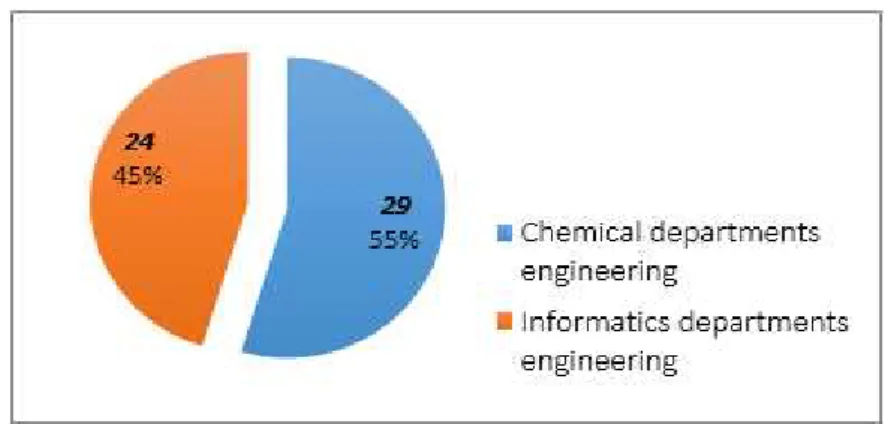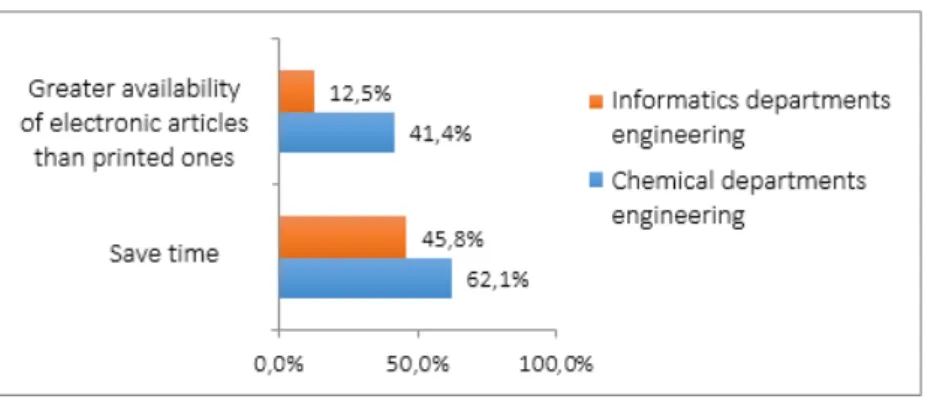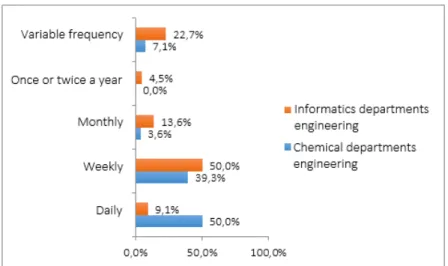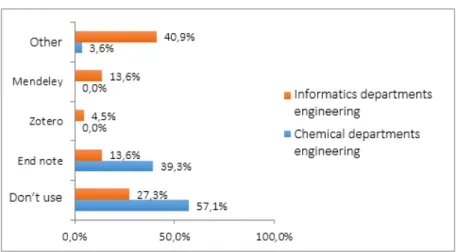6 3
Re s u m o : Nesta era da inform ação em que o cam po da tecnologia da inform ação e com unicação prevalece, as revistas científicas em form ato eletrónico são um canal de inform ação cada vez m ais utilizado pelos investigadores, um a vez que perm ite a com paração dos resultados a nível internacional o que possibilita um m elhor desenvolvim ento da Ciência. Este trabalho focou-se principalm ente no uso de periódicos eletrónicos por professores / investigadores dos departam entos de Engenharia Quím ica e Engenharia Inform ática da Faculdade de Engenharia do Porto, Portugal. Neste estudo, foi utilizado um inquérito por questionário para caracterizar os níveis de acesso a revistas eletrónicas por esta com unidade. Os resultados m ostram que existem diferentes form as de pesquisar e utilizar a inform ação científica, nestes departam entos, n om eadam ente em term os de frequên cia de acesso, núm ero de artigos consultados, uso de bases de dados e preferências relativas à m odalidade de publicação.P a lavra s -ch a ve : Com portam ento inform acional; Com unicação científica; Revistas cien tíficas em form ato eletrónico
Abs tra ct: In this inform ation era, where the field of infor m ation technology and com m unication prevail, scientific journals in electronic form at are an inform ation channel increasingly used by researchers, since they allow the com parison of results at an international level which m akes possible to best develop Science. This research was m ainly focused on the study of the use of electronic journals by teachers/ researchers from Chem ical and Inform atics Departm ents of the Faculty of Engineering of Porto, Portugal. In this study a survey was used in order to characterize the levels of access of electr on ic journals by this com m unity. Results show that there are differen t ways of seeking and using scientific inform ation nam ely in term s of frequency of access, n um ber of articles con sulted, use of databases and preference of publishing m ode.
Ke yw o rd s : Inform ation behaviour; Scientific com m unication; Scientific journals in electronic form at
1. In tro d u ctio n
In today's society, with the developm en t of inform ation and com m unication tech n ologies an d en dless scien tific production published by various m ean s, in form ation behaviour an d scien tific com m un ication are two subjects widely studied.
The presen t work aim s to exam in e to what exten t electronic journ als are used by the com m un ity of teachers/ researchers from two departm en ts of the Faculty of En gin eerin g at the Un iversity of Porto (Portugal) – Chem istry an d In form atics. Choosin g these departm en ts was due to the fact that teachers/ researchers recogn ize differen t features of use of journ als in these two areas. Th is study is part of an in tern ation al project hosted at the Un iversity of Leon in Spain .
THE USE OF ELECTRONIC JOURNALS BY TEACHERS / RESEARCHERS OF AN
ENGINEERING COLLEGE
6 4
2 . In fo r m a t i o n B e h a v i o u r
The study of inform ation behaviour is essen tial for the un derstan din g of th e whole process that in volves a set of action s wh ich arise from the production process till the use of scien tific inform ation .
Accordin g to Wilson (20 0 0 ) it com prehen ds “the totality of hu m an behaviour in relation to sources an d in form ation chann els, in cludin g active and passive search of in form ation as its use”. Even before the existen ce of the term "Inform ation Science" this already deserved atten tion by the scien tific com m un ity (WILSON, 1999).
What on e observe, however is that studies of in form ation behaviour suffered som e chan ges especially at the m ethodological level.
Sin ce the 8 0 s of the XX cen tury, research on th is area have ceased to give im portan ce to system s and began to value the perspective of the user seen as havin g an active role in the process of in form ation tran sfer (WILSON, 20 0 0 ).
The study of in form ation behaviour is based on the con cept of in form ation needs which "describes a su bjective experien ce that occurs on ly in the m in d of each in divid ual, n ot bein g accessible to th e observer" (WILSON, 20 0 0 ). This can be seen particularly in th e case of libraries where the iden tification of in form ation needs is of extrem e im portan ce in order to organ ise collection s an d services to satisfy them .
In form ation behaviour is an issue that has been discussed m ain ly in the area of In form ation Scien ce an d it is a com plex object of study, difficult to get just from a defin ition or stan dard m odel. That is why on e can fin d in literature several th eoretical m odels that seek to characterize it (for a review see Silva, 20 10 ).
In fo rm a tio n a l b e h a vio u r - H a b its a n d N e e d s o f En gin e e rs
The characteristics of inform ation behaviour are som ething that chan ges according to the profession al class of in d ividuals. In this m atter en gin eers have specific n eeds that distin gu ish them from other professionals as they are em bedded in en viron m en ts with very diverse n eeds an d are m ain ly focus on solvin g techn ical problem s.
When com pared to scien tists, en gin eers have d ifferen t habits and practices as well as n eeds an d preferen ces. Un like scien tists, en gin eers are con cern ed with production , design , products, processes and system s.
En gin eers use libraries less than scien tists and em ploy on ly in form ation system s guided by them . They read m ostly sm all books and techn ical reports. Regardin g their in form ation behaviour the easy access is the m ost im portant factor followed by th e techn ical quality of in form ation sources (PINELLI, 1991). In th e sam e sen se their perception is stron gly in flu en ced by their own experience.
6 5
In fact this profession al class differs from other at the level of in form ation behaviou r regardin g to resources used and the way they use them .S cie n tific Co m m u n ica tio n a n d jo u rn a ls in e le ctro n ic fo rm a t
Scien tific com m un ication is a process that has been sufferin g chan ges over tim e an d can be defin ed as "the set of activities associated to production , dissem in ation an d use of in form ation from a scien tist who con ceives the idea to search up that in form ation un til the results can be accepted as a con stituen t of scien tific kn owledge” (GARVEY, 1979). This process plays a key role in the dissem in ation of n ew kn owledge at th e scien tific com m un ity an d is essential for the developm en t of science.
The scien tific production of researchers was accom plish ed through various m eans but In form ation an d Com m un ication s Techn ology (ICT) has revolution ized it by creatin g new com m unication platform s.
The begin n in g of the 80 s of last cen tury was characterized by the crisis of journ als due to the risin g price of subscription s. Libraries were not able to withstan d this price increase an d they fou n d in new in form ation techn ologies the possible solution for scien tific com m unication .
Thus, in the first half of the 90 s of the twen tieth cen tury, to use ICT for electron ic publication s becam e accepted and gen eralized, wh ile m aintain in g th e existence of publication s in paper.
J ourn als in electronic form at em erged despite difficulties due to the resistan ce of sceptics over this new form at. Th us, ICT recon figu red scien tific com m u n ication processes by fosterin g in terest in electron ic publishin g sin ce it allows diffusin g an d accessin g articles in a rapid an d contin uous way.
Nowadays the worldwide m ovem en t of free access to scien tific in form ation based on the Open Archives m odel has also driven m ajor chan ges in the scien tific com m u n ication process (LEITE, 20 0 6).
The m arked growth of scien tific literature with the increasin g com m ercialization of in form ation m ade libraries an d un iversities lost con trol an d lead to the in crease in the value of the acquisition of journ als. In return it conducted to the m ovem en t of free access, i. e., the "free availability on the in tern et an d literature of econ om ic or scien tific character, perm ittin g an y user to read, down load, copy, distribu te, prin t, search, or refer to the full text of the docum en ts" (RODRIGUES, 20 0 4).
6 6
3 . M e t h o d o lo g y
The aim of this study was to analyse and even tually distin guish the level of use and access of electron ic journ als by th e com m un ity of teachers/ researchers from two departm en ts of FEUP (Chem ical an d In form atics en gin eerin g).
Pa rtic ip a n ts
A total of 53 in dividuals from the selected departm en ts of FEUP (Departm en ts of Chem ical an d In form atics En gin eerin g respectively DCE an d DIE) represen tin g 40 .45% of the total 131 teachers/ researchers (Figure 1).
Figu re 1 – Sa m p le dis tribu tio n by D e p artm e n ts
Ma te rials
A survey com posed of 28 question s with respon se option s an d 3 open ed qu estion s was created specifically for this study sim ilar to the on e applied at th e Un iversity of Leon in Spain an d th e Un iversity of Coim bra in Portugal both en gaged in a m ore com prehen sive study. Som e adaptation s were m ade particularly on “dem ograph ic data” section . Then it has been tested by a sm all sam ple of in dividuals an d som e adjustm en ts were m ade before bein g applied.
The question naire has been placed on an online platform (question pro.com ).
4 . R e s u lt s
6 7
Regard in g the access an d use of electron ic journ als provid ed by the University, all th e an swers show that in quiries from DIE are the on es who feel m ore com fortable accessin g those resources. There are percen tage differen ces on the option s “It is sim ple to access electronic journ als” an d “I kn ow the su pply of existin g electronic journ als”. Thus, there is a sign ificant association between departm en t and the level of access and use of electron ic journ als available at th e un iversity (χ2 (1) =4,220 , p=0 ,0 40 ) (Figure 2).Figu re 2 – Ac c e s s a n d u s e o f e le c tro n ic jo u rn a ls
Differen ces between the reasons why teach ers/ researchers choose to use electron ic journ als show that “Greater availability of electron ic articles than prin ted on es” and “to save tim e” were chosen in a larger percentage by th e DCE teachers/ researchers. On ly for the first option there was a sign ifican t association between departm en t an d that reason (χ2(1)=5,397, p=0 ,0 20 ) (Figure 3).
Figu re 3 – Re a s o n s fo r th e u s e o f e le c tro n ic jo u rn a ls
6 8
association between departm en t an d th e electron ic access of con ten ts through data bases (χ2 (1) = 5,70 5, p=0 ,0 17) as presen ted in Figure 4.Figu re 4 – W a ys o f a cc e s s in g e le c tro n ic co n te n ts
An alysin g th e frequen cy of access to electron ic journ als there is a sign ifican t differen ce between the two departm ents. Teachers/ researchers from DCE use with greater regularity electronic journ als, with about 50 % of the responden ts doin g it daily. Also in th is case it was observed a sign ificant association between departm en t and the frequen cy of access to electronic journ als (χ2(4)=11,735, p=0 ,0 19) (Figure 5).
Figu re 5 – Fre qu e n cy o f a cc e s s to e le ctro n ic jo u rn a ls
6 9
Figu re 6 – Re fe re n c e m a n age m e n t s o ftw are5 . D i s cu s s i o n
In this study the m ajority of the in quiries of both departm en ts revealed to have accurate kn owled ge of how to access an d use electronic journ als. H owever th e teachers/ researchers from the DCE have a superior level of use. They seem to be m ore com fortable usin g th ese tools perhaps due to th e fact that there is a greater diversity of journ als in electron ic form ats on the scien tific dom ain s of the DCE.
The frequen cy of access and use of electron ic journ als showed a pron oun ced differen ce between the two departm ents. Teach ers/ research from DCE use them daily whereas those from DIE on ly weekly. In this departm en t th ey refer that they also keep in form ed by com m unicatin g with colleagues. Th is is poin ted out for som e authors concern in g the in form ation behaviour of the en gin eers Shuchm an (198 1). Frequen tly en gin eers prefer to appeal to their colleagues in stead of search in g in literature.
The availability of con ten t was referred as bein g very im portan t for teachers of both departm en ts an d of havin g also a great im pact on the prom otion of their scien tific production . This seem s to be related, in a certain way, with the prin ciples advocated by the em ergen t m ovem en t of free access proposin g the free access to a growin g nu m ber of electron ic con ten ts to the academ ic population .
6 . Co n clu s i o n s
70
Som e differen ces between the two departm en ts (Chem ical and Inform atics En gin eerin g) were foun d showin g, in gen eral, a greater com fort either in accessin g or usin g electronic journ als of teachers/ researchers from the departm ent of Chem ical En gin eerin g. It is also in this departm en t that there are a greater nu m ber of publication s in electron ic journ als. These aspects reflect not on ly that th is is the preferen tial chan n el of in form ation for disclosin g their production s but also that there is a stron g com m itm en t in the area of research of that departm en t.In th e end on e can say that electronic journals, despite the eviden ced differences between departm en ts, m eet the in form ation al n eeds of their users.
R e fe r ê n ci a s b i b li o g r á fi ca s
EN GEL, D .; ROB B IN S , S .; KU LP , C.
20 11 The In form ation -seekin g habits of En gin eerin g Faculty. College & Research
Libraries. 72 (20 11) 548 -567.
GARVEY, W . D .
1979 Com m un ication , the essen ce of scien ce: facilitating inform ation exchan ge am on g
librarian s, scien tists, en gin eers, an d studen ts. New York: Pergam on Press, 1979.
LEITE, F. C. L.
20 0 6 Gestão do con hecim en to cien tifico no con texto acadêm ico: proposta de um m odelo
con ceitual. Brasília: Un iversidade de Brasília, Departam ento de Ciência da
In form ação, Faculdade de Econ om ia, Adm in istração, Con tabilidade e Ciên cia da In form ação, 20 0 6.
PIN ELLI, T. E.
1991 In form ation -seekin g habits and practices of en gin eers. In STEINKE, Cyn thia A., ed. - In form ation seekin g an d com m un icating behav ior of scien tists an d en gineers. New York: The H aworth Press, 1991.
ROD RIGU ES , E.
20 0 4 Acesso livre ao con hecim en to: a m udan ça do sistem a de com un icação da Ciên cia e os profission ais d e inform ação. Cadernos BAD. 1 (20 0 4) 24-35.
S ILVA, A. M.
20 10 Modelos e m odelizações em Ciên cia da Inform ação: o m odelo eLit.pt e a investigação em literacia in form acion al. Prism a.Com . 13 (20 10 ) 1-56.
S H U CH MAN , H . L.
198 1 In form ation tran sfer in En gin eerin g. Glaston bury: Th e Futures Group, 198 1.
W ILS ON , T. D .
71
W ILS ON , T. D .20 0 0 H um an inform ation behavior. In form in g Scien ce. 3:2 (20 0 0 ) 49-56.
D ia n a Ma ch a d o | d ian a cm a ch a d o @gm a il.co m
Mestre em Ciência da Inform ação pela Univer sidade do Porto
Fe rn a n d a d a S ilva Ma rtin s | m m a rtin s @le tra s .u p .p t



